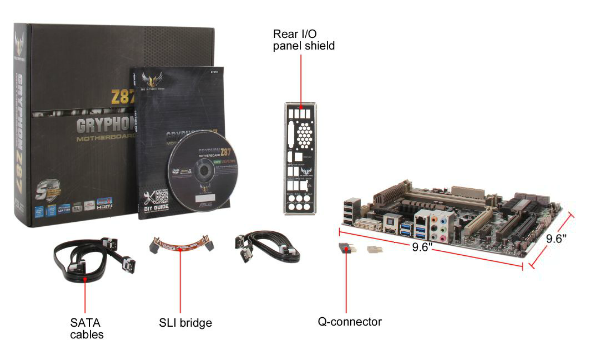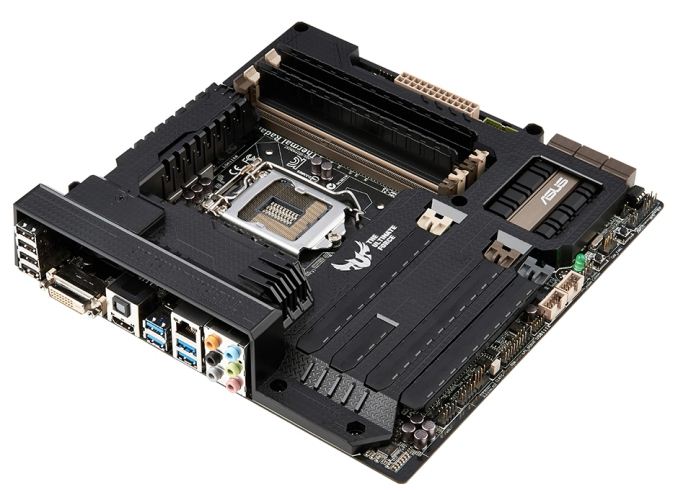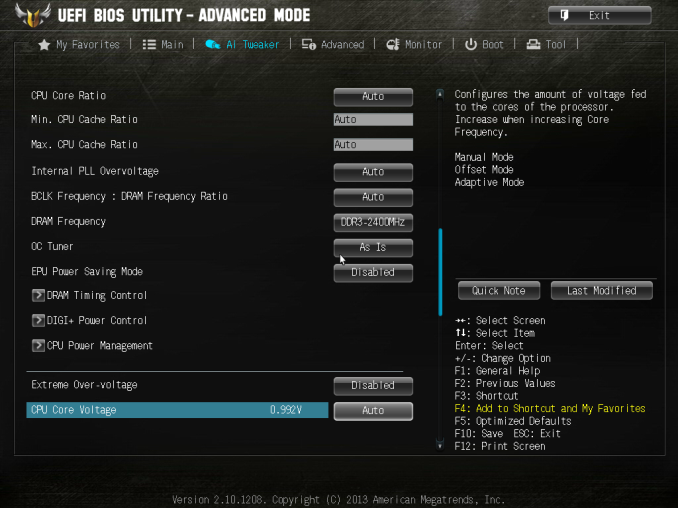ASUS TUF Z87 Gryphon Review
by Ian Cutress on February 3, 2014 10:00 AM EST- Posted in
- Motherboards
- Asus
- Z87
- TUF
ASUS TUF Z87 Gryphon In The Box
Looking back on the original outset of the review, I guess I had no inclination as to what exactly the box of a TUF motherboard would have in it. Given the market for the TUF is towards the longevity and stability of a product, one could argue that safety could be tacked on as well and some form of modified screws with a special screwdriver could be added. Given that the Z87 Gryphon is a ~$162 motherboard, the box contains the following:
Driver DVD
Rear IO Shield
Manuals
Four SATA Cables
Flexi-SLI Bridge
Q-Connectors
Ultimately this is almost the bare minimum ASUS could have put in the box – remove a couple of SATA cables and the SLI bridge would be the minimum compared to what we have seen with lower price segmentation. There is scope here for ASUS to have included something to represent the TUF brand, such as a sticker for a case or a poster. Though I guess what ASUS want users to buy is the Armor Kit, available separately:
ASUS TUF Z87 Gryphon Overclocking
Experience with ASUS TUF Z87 Gryphon
As one might imagine, a motherboard built for stability might not necessarily pull out all the stops to become the best overclocking motherboard on the market. This is probably seen best by the Gryphon’s lack of automatic overclock options – we only found two, and these were further down the overclocking page in the BIOS.
That being said, if ASUS was attempting to escape overclocking, they would have used the H87 chipset. Using some intuition and the manual overclock settings, our CPU still managed to hit the 4.6-4.7 GHz range similar to previous Z87 motherboards we have tested. Motherboards built for longevity and overclocking motherboards are often cut from similar bits of cloth, although the testing applied to either will be different.
Methodology:
Our standard overclocking methodology is as follows. We select the automatic overclock options and test for stability with PovRay and OCCT to simulate high-end workloads. These stability tests aim to catch any immediate causes for memory or CPU errors.
For manual overclocks, based on the information gathered from previous testing, starts off at a nominal voltage and CPU multiplier, and the multiplier is increased until the stability tests are failed. The CPU voltage is increased gradually until the stability tests are passed, and the process repeated until the motherboard reduces the multiplier automatically (due to safety protocol) or the CPU temperature reaches a stupidly high level (100ºC+). Our test bed is not in a case, which should push overclocks higher with fresher (cooler) air.
Automatic Overclock:
The automatic overclock settings are found in the OC Tuner option of AI Tweaker in the BIOS. Selecting this gives two further options to select: Ratio First and BCLK First.
Selecting Ratio First gives a CPU multiplier of 43x/42x/42x/41x, meaning 4.3 GHz in single thread mode down to 4.1 GHz at full load. Over the base CPU turbo, this means an extra 300 MHz on the single thread setting. The BIOS still showed ‘Auto’ for CPU voltages and Load Line Calibrations, and in the OS this gave a load reading of 1.136 volts. PovRay scored 1696.45, and OCCT gave a maximum temperature of 71C. XMP was applied automatically also.
On the BCLK First option, the CPU was adjusted to the 125 MHz strap, giving a 34x125 scenario for all threads, or 4.25 GHz all over. Again the BIOS reported an automatic setting for voltages, although in the OS this meant 1.174 volts during OCCT with a peak temperature of 75C. PovRay scored 1757.7.
Manual Overclock:
For our manual overclock we stayed in the BIOS and started from 4.0 GHz and 1.000 volts. When the system was stable (PovRay + 5 mins OCCT) the multiplier was raised, and for any failure the voltage was raised by +0.025 volts using a fixed voltage application. The following results were achieved:
At 4.7 GHz the system was stable but failing our OCCT temperature tests, giving over 90C. Despite using a TRUE Copper heatsink for this test, better cooling would be needed to push the CPU further.














62 Comments
View All Comments
FractinJex - Monday, February 3, 2014 - link
Im currently running this board in a CoolerMaster N200 mATX build and its awesome! Just like the sabertooth its rock solid and built to last until upgrade 4-5 years...i7 4770
MSI GTX 780 Ti 1225mhz
8gb 2400 Gskill
AX860
Firestrike score - 11313
tim851 - Monday, February 3, 2014 - link
>its rock solid and built to last until upgrade 4-5 years...<Yeah, unlike all the normal motherboards that explode after 3 years... *rollseyes*
5thaccount - Monday, February 3, 2014 - link
Yeah, haha, all my systems last far beyond 5 years - but that's because I refuse to use ASUS motherboards! ASUS hasn't made quality motherboards for 15 years. Every month I see hundreds of ASUS motherboards thrown out because they died or have some problems. MSI also has a high failure rate, but unlike ASUS, they actually honor their warranty.munim - Monday, February 3, 2014 - link
Yeah, haha, all my systems last far beyond 5 years - but that's because I refuse to use MSI motherboards! MSI hasn't made quality motherboards for 15 years. Every month I see hundreds of MSI motherboards thrown out because they died or have some problems. Asus also has a high failure rate, but unlike MSI, they actually honor their warranty.maximumGPU - Tuesday, February 4, 2014 - link
Love it!Senti - Monday, February 3, 2014 - link
Why so much hate towards Asus to even spam the same nonsense (zero examples) from multiple accounts?Asus does make nice boards, just a bit overpriced maybe.
My oldest MB still in use is Asus K8N4-E Deluxe: that's 8 years of use (with overclocking too)! Just had to replace CMOS battery recently.
FractinJex - Monday, February 3, 2014 - link
They are both trolls....I handle multiple MB vend/manf. on a daily basis and Asus is still one of the best consumer/enthusiast brands available simply as that....MSI is right up there as well with their xpower etcEtsp - Monday, February 3, 2014 - link
munim isn't supporting 5thaccount, they are pointing out how ridiculous 5thaccount's post is, by using the same exact wording and swapping the brands.Samus - Monday, February 3, 2014 - link
Lmfao is this guy serious? Asus has always made some of the best motherboards going way back to the 80's.5thaccount - Tuesday, February 4, 2014 - link
My hate is strictly for ASUS' motherboards and RMA process. Everything else I've seen from ASUS has been of reasonable to excellent quality. 'munim' is someone not related to me. I'm not going to give specific examples or identify myself, but since the 90s I've worked as a technician, at very large reseller (at one time was the largest reseller of video cards in the world - although we sold every other part too), and currently at an electronics recycling company. I see things on an enormous scale and from a unique perspective. We see tons of the latest technology running through our doors, and ASUS motherboards are a running joke (from my experience their reliability has been spotty since their Socket A / 462 boards - prior to that they were bulletproof). Anyhow, no one has to believe a word of what I just said - won't affect me one way or the other.